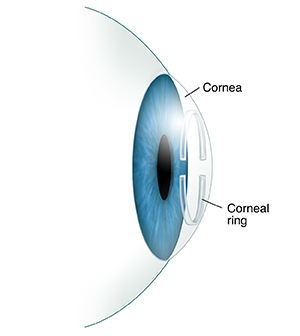Having Corneal Ring Implantation
Corneal ring implantation is a procedure to insert a small ring of plastic into the cornea. It is put into the middle layer of the cornea. This is done to fix an eyesight problem and let you see more clearly.
What to tell your healthcare provider
Tell your healthcare provider about all the medicines you take. This includes over-the-counter medicines, such as ibuprofen. It also includes vitamins, herbs, and other supplements. And tell your healthcare provider if you:
-
Have had any recent changes in your health, such as an infection or fever
-
Are sensitive or allergic to any medicines, latex, tape, or anesthesia (local and general)
-
Are pregnant or think you may be pregnant
Tests before your procedure
You may need some special exams before your procedure. Your eye care provider may want to use special tools to shine a light in your eye and look at your cornea. You may need to have your eyes dilated for this eye exam. You also may need computerized corneal mapping. This will give your healthcare provider more information about your cornea. Another test, optical coherence tomography, is important in evaluating your cornea.
Getting ready for your procedure
Talk with your healthcare provider about how to get ready for your surgery. You may need to stop taking some medicines before the procedure, such as blood thinners and aspirin. If you smoke, you may need to stop before your surgery. Smoking can make your healing take longer. Talk with your healthcare provider if you need help to stop smoking.
Also, make sure to:
-
Ask a family member or friend to take you home from the hospital. You can't drive yourself.
-
Follow any directions you are given for not eating or drinking before your surgery.
-
Follow all other instructions from your healthcare provider.
You will be asked to sign a consent form that gives your OK to do the procedure. Read the form carefully. Ask questions before you sign if something is not clear.
The day of your procedure
Your procedure will be done by an eye surgeon. The surgery can be done in several ways. Ask your surgeon about the details of your surgery. In general, you can expect:
-
You will likely be awake during the surgery. You will get medicine to help you relax. You may also be given anesthetic eye drops and shots. These are to make sure you don’t feel anything during the procedure. In some cases, you may have general anesthesia to put you to sleep. If this is the case, you will sleep through the surgery.
-
Your surgeon will make small cuts in the outer edge of your cornea.
-
The surgeon will make tunnels under the outer layer of your cornea. Sections of the ring are put into these tunnels.
-
The surgeon will close the cuts on the cornea with very small stitches (sutures).
-
They may put an antibiotic ointment on your eye. This is to help prevent infection.
-
The surgeon will close your eye and cover it with a bandage.

After your procedure
You may be able to go home the same day. It's very important to follow your discharge instructions. Plan to have someone go home with you after the procedure. You may not be able to see well right away because of eye swelling. Make sure to:
-
Follow all of your healthcare provider’s instructions.
-
Not rub your eyes.
-
Use antibiotic eye drops if told to do so. These are to help prevent infection.
-
Take over-the-counter pain medicine if needed. Your eye may be a little sore after the procedure.
-
Wear an eye patch or keep the bandage on for a day or so if told to do so.
-
Ask your eye care provider which activities you should not do as you get well.
Follow-up care
Make sure to keep all of your follow-up appointments. You will need close follow-up care so your eye care provider can see if the procedure worked. You may have an appointment the day after the procedure.
When to call your healthcare provider
Call your healthcare provider right away if you have any of these
-
Decreased eyesight
-
Eye redness that gets worse
-
Eye pain that gets worse even after taking pain medicine
-
Eye swelling that gets worse
Online Medical Reviewer:
Heather M Trevino BSN RNC
Online Medical Reviewer:
Vinita Wadhawan Researcher
Online Medical Reviewer:
Whitney Seltman MD
Date Last Reviewed:
10/1/2024
© 2000-2025 The StayWell Company, LLC. All rights reserved. This information is not intended as a substitute for professional medical care. Always follow your healthcare professional's instructions.